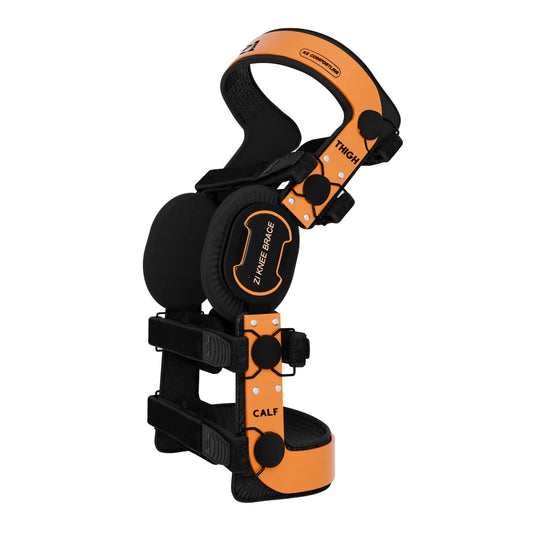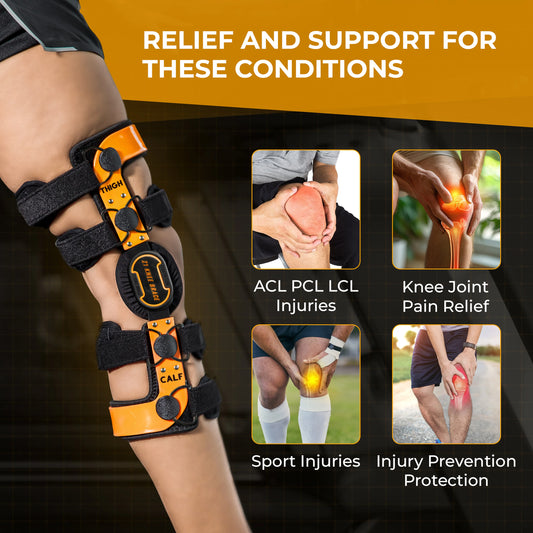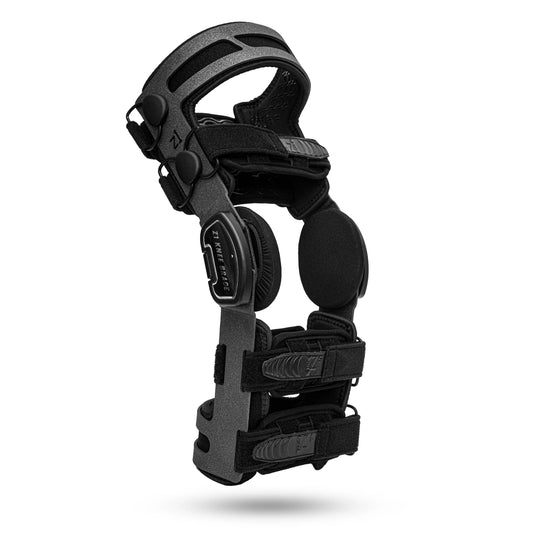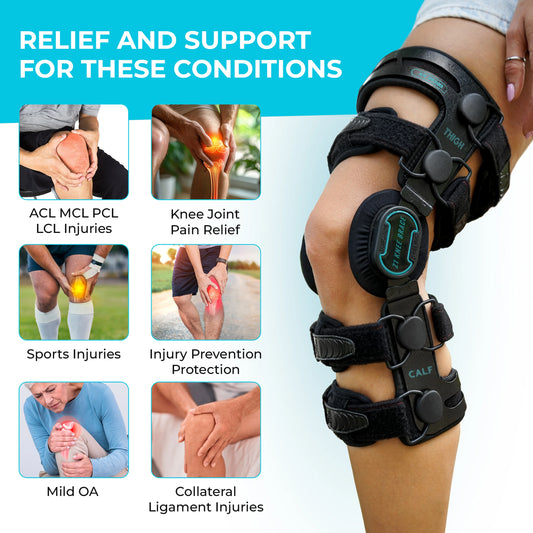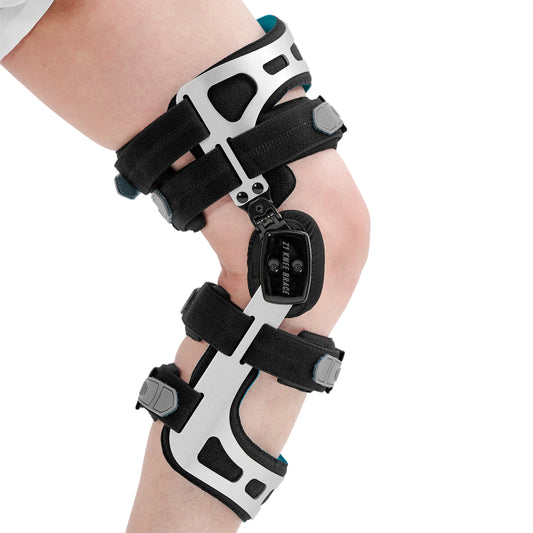Offloader Knee Brace - A Complete Beginner’s Guide

An offloader knee brace is a biomechanical orthopedic device which modifies the single compartmental load distribution of your knee. It is designed to reduce the pressure or painful part of the knee & joints and shifts the pressure to the undamaged part of the knee. It is helpful in relieving pain & improving mobility.
During walking, your knee joint bears 3 - 4 times the weight of your body. A little misalignment in your knee can create extra pressure on your joint, which increases the extra pressure on your joint cartilage. Cartilage damage can create synovial inflammation which activates the pain receptors to create chronic joint pain.
In this complete guide, we will understand the step-by-step working mechanism of offloader knee braces with its real-time benefits and how it manages the Osteoarthritis problem.
The Structure of an Offloader Knee Brace -
The structure of an offloader knee brace typically includes -Rigid Outer Frame -
The rigid outer frame is often made of aluminum alloy. It creates the corrective alignment forces for your knee.
Adjustable Polycentric Hinges -
There are multiple polycentric hinges placed at the knee sides. They are liable for controlling extension & flexion for the knee joint. They also mimic the natural motion of the knee.
Velcro Straps -
The offloader knee brace is also featured with velcro or buckle straps on the thigh and calf. These straps are liable for customized fitting & maintain the shape of knee brace in the perfect biomechanical position.
Condyle Pads -
These are the cushioned pads located near the knee condyles. It also manages the proper pressure distribution & stabilizes the brace’s corrective force.
Suspension System -
The suspension system of offloader knee brace works for stopping the brace slippage during physical activity or walking. It often includes the silicon padding for improving the overall grip.
How an Offloader Knee Brace Works -
Let’s explore the working of the offloader knee brace by the following steps -- Most people with knee osteoarthritis have damage on inner & outer compartments. An offloader knee brace is designed to reduce the load on the affected compartment and transfer it to the healthier compartment.
- An offloader knee brace applies its force in three places - one on the thigh, one on the calf, & the last near the knee. It reduces bone-on-bone contact and improves shock absorption during walking.
- If your knee naturally bends inward or outward (varus & valgus deformity), the offloader brace shifts the alignment to the more neutral position. It increases the mobility & reduces the grinding sensation.
- The structural framework of the frame & adjustable straps helps the weak ligaments & reduces the risk of knee collapse.
- By mechanically unloading the pressure from the affected area, with the brace you can walk longer, stand without discomfort, & it also reduces painkillers dependence.
Key Benefits of Using an Offloader Knee Brace -
There are many key benefits of using an offloader knee brace for a joint patient -- The offloader knee brace subtly improves the movement of your knee in the healthy walking dimension, reducing long-term wear on the joint.
- This brace dampens the tiny shock waves that normally injures the cartilage & soft tissues.
- Offloading reduces the nerve endings around the damaged compartment and lowers the pain sensitivity.
- The quadriceps & hamstrings don’t overwork to keep your knee stable because the offloader brace shares the load.
- An offloader knee brace also improves the joint proprioception, which enhances the contact between the knee & your brain.
- The 3-point force system protects your knee during quick turns, & uneven terrain.
- Standing in queues, managing household activities, physical activities & walking becomes much easier due to reduced knee load.
- By load distribution, the brace prevents the swelling, inflammation, burning pain & the feeling of weight.
- With less compression, the joint reduces grinding and catching.
Types of Offloader Knee Braces -
There are many types of offloader knee braces -Hinged Offloader Knee Brace -
A hinged offloader knee brace is a knee support device, which mixes unloading technology with metallic hinges to relieve pressure from the affected part of your joints. It helps the unstable & weak ligaments. Their working processes are based on two processes - unloading & hinged support mechanism.
Adjustable Offloader Knee Brace -
An adjustable offloader knee brace is a type of knee brace in which you can manually control how much pressure can be shifted away from the knee’s painful side. It is a customisable knee brace based on their pain level & osteoarthritis severity. It is equipped with dials, sliders, or screws with which you can shift away the corrective force on the knee.
Custom-Molded (Custom-Fitted) Offloader Knee Brace -
These knee braces are the specific ones which are designed to match the exact shape, alignment, and biomechanics of your knee. It is built by using a 3D scan, cast, or digital measurement of your knee. They work effectively in mild varus/valgus correction. It applies the targeted offloading force to the painful knee compartment. The targeted alignment encourages smoother movement & reduces bone compression.
Medial Offloader Knee Brace -
A medial offloader knee brace is designed for those people who are suffering through osteoarthritis affecting the medial compartment of the knee. It shifts the pressure from the inner compartment to the outer compartment where the cartilage is healthier. It is effective in the varus deformity where the knee bends inward due to unexcessive load.
Lateral Offloader Knee Brace -
A lateral offloader knee brace is designed for those individuals who are suffering from osteoarthritis affecting the lateral compartment of your knee. This brace also works effectively against the valgus deformity, where the knee bends outward. With the proper alignment, a user experiences better control, better joint stability, & sudden knee buckling.
How to Wear an Offloader Knee Brace Properly? -
An offloader knee brace applies the corrective force to the deceased knee for joint stability. The proper placement of your knee brace ensures you get maximum pain relief. You can follow these steps to wear offloading knee brace properly -- If your inner part is afflicted then you should use the medial one and vice versa in the case of the lateral part.
- Before wearing it, open the brace correctly, lose every strap, and ensure the hinges are not twisted.
- Place the brace on the leg to align the hinges with the center of your knee side-by-side.
- Close the upper frame around your thigh first. Then wrap the lower frame around your calf to match your knee perfectly.
- Now you can tighten the thigh strap, then calf & lower straps.
- If your brace has an allen key or dial key mechanism, then you should start using it by applying the minimal force. Never start with the maximum correction.
- You can also choose a knee sleeve before wearing the knee brace to prevent skin irritation. Don’t wear it on sweaty or oily skin.
- To remove the brace slowly, sit down and release the straps one by one.
Final Thoughts -
An offloader knee brace is a game-changer for anyone who is suffering from osteoarthritis, chronic joint pain, & joint imbalance. This guide works as a starting point for those who want to understand the importance of distribution of pressure on the joints to reduce pain & increase mobility.An offloader knee brace is not just an offloading pressure device against joint pain but also a mobility partner. Pairing it with proper diagnosis, physiotherapy, strengthening exercises, and lifestyle adjustments, it can improve your knee health. With the correct offloader knee brace, you can gain freedom from pain and gain more momentum.

